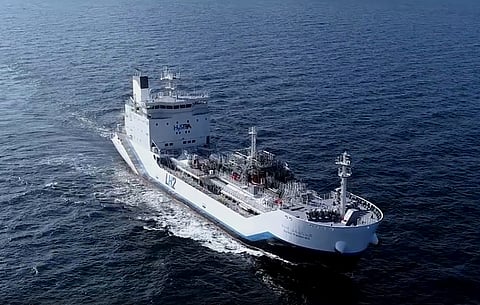

Kawasaki Heavy Industries (KHI) has delivered a new liquefied hydrogen carrier to the CO2-free Hydrogen Energy Supply-chain Technology Research Association (HySTRA), a consortium of Japanese companies that include KHI, Iwatani Corporation, Shell Japan, Electric Power Development Company (J-Power), Marubeni Corporation, JXTG Nippon Oil and Energy Corporation, and Kawasaki Kisen Kaisha (K Line). The vessel has been appropriately named Suiso Frontier, "suiso" being the Japanese translation of hydrogen.
Suiso Frontier is most notable for being the world's first purpose-built liquefied hydrogen carrier. Equally notable is the fact that its design also took into account the need to constantly evaluate how its onboard equipment and systems performed under normal operating conditions, since the vessel is the first to be utilised specifically for the transport of this relatively new type of cargo.
Suiso Frontier was developed primarily to provide a means of transporting liquefied hydrogen (LH2) at 1/800 of its original gas-state volume, cooled to –253 degrees Celsius, safely and in large quantities over long distances by sea. This is made possible thanks to a new 1,250-cubic-metre, vacuum-insulated double-shell-structure stainless steel LH2 cargo tank specially developed by Harima Works, a subsidiary of KHI. The support structure for the tank is made of highly durable FRP to further ensure a reduction in heat transfer.
The cargo tank's vacuum-insulated construction is also intended to help deal with the phenomenon of boil-off wherein heat inadvertently converts the LH2 back into gas form and thus increases the pressure within the tank. This unwanted but inevitable occurrence in LNG tanks is potentially more severe in an LH2 tank since LH2 evaporates up to ten times faster than LNG. To address this problem, a compressorless, hydrogen-compatible gas combustion unit (GCU) supplied by industrial burner manufacturer Saacke will ensure that any boil-off gas is completely and safely combusted to reduce the risk of increased pressure.
The NK-classed Suiso Frontier has an LOA of 116 metres, a moulded beam of 19 metres, a depth of 10.6 metres, a draught of 4.5 metres, a gross tonnage of approximately 8,000 tonnes, and accommodations for 25 crewmembers. A propulsion system consisting of three Daihatsu DE-23 1,320kW diesel engines and two 1,360kW electric motors enables the vessel to sail at speeds of up to 13 knots. The diesel engines also feature selective catalytic reduction (SCR) technology, ensuring compliance with IMO Tier III NOx regulations.
Suiso Frontier operated for much of 2020 as a technology demonstrator for HySTRA, whose main objective is to establish an international hydrogen energy supply chain between Australia and Japan. Brown coal that is mined in Latrobe Valley in Victoria is processed and converted into LH2, which the vessel will then transport to a receiving terminal in Kobe. Round trips will be scheduled once every few months.
Interestingly, the operation of the vessel is also aiding the Society of International Gas Tanker and Terminal Operators (SIGTTO), a global non-profit, in the formulation of best practices and other future guidelines related to the safe carriage of LH2, which had never before been envisaged as a regular bulk cargo to be carried at sea due to its extremely low temperature at atmospheric pressure, its unusually high upper explosive level, its extended flammable range, and its very small molecular size. SIGTTO General Manager Andrew Clifton said that monitoring and understanding of Suiso Frontier's regular operations are expected to yield valuable knowledge that will benefit not only SIGTTO members, but also the shipping industry at large.
Suiso Frontier began operational sailings in early March 2021. The vessel is set to soon begin undergoing a one-year pilot phase wherein HySTRA will evaluate its performance and determine whether to proceed to full commercial implementation of the hydrogen supply chain. The implementation would lead to the development of a new range of higher-capacity LH2 carriers beginning no later than 2026.
| Suiso Frontier | |
| SPECIFICATIONS | |
| Type of vessel: | Liquefied hydrogen carrier |
| Classification: | ClassNK |
| Flag: | Japan |
| Owner: | CO2-free Hydrogen Energy Supply-chain Technology Research Association, Japan |
| Operator: | CO2-free Hydrogen Energy Supply-chain Technology Research Association, Japan |
| Builder: | Kawasaki Heavy Industries, Japan |
| Length overall: | 116 metres |
| Beam: | 19 metres |
| Draught: | 4.5 metres |
| Depth: | 10.6 metres |
| Deadweight tonnage: | 9,000 |
| Gross tonnage: | 8,000 |
| Capacity: | 1,250 cubic metres |
| Main engines: | 3 x Daihatsu DE-23, each 1,320 kW |
| Auxiliary engines: | 2 x 1,360 kW |
| Maximum speed: | 13 knots |
| Other equipment installed: | Saacke gas combustion unit |
| Type of fuel: | Diesel |
| Crew: | 25 |
